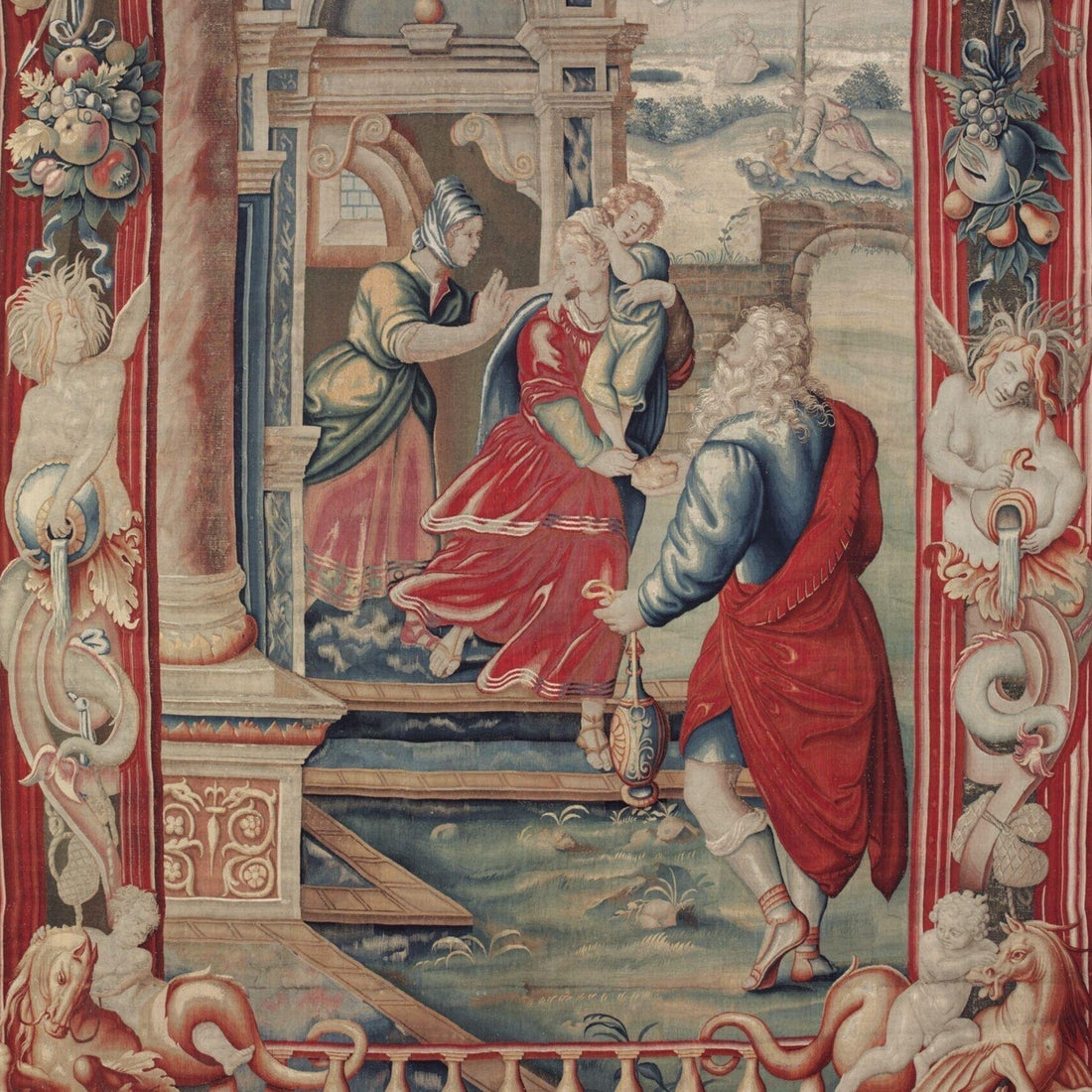
Cartoons and Kingdoms: Mortlake’s Tapestry Tales
Between the 8th and 14th centuries, tapestries were highly fashionable, and because they were expensive, much more so than paintings, they were a way of showing off one’s wealth and taste. In some cases, what they depicted could be a subtle form of propaganda. Tapestries were frequently created as sets covering the walls of huge rooms. Unlike paintings, they were flexible and could be rolled up and transported, something of practical use when it was usual for the nobility to travel to and spend time at their other residences. Once in situ, the tapestries had a further function; in those pre-central heating days, they preserved warmth in the big draughty rooms of great houses, and the stories they depicted also provided entertainment and a refined talking point for guests.
Rulers, including the Medicis and Peter the Great, had their own tapestry factories. James 1 and his son Charles, Prince of Wales, both tapestry enthusiasts, encouraged the Prince’s secretary, Sir Francis Crane, to purchase, set up, and run the Mortlake Tapestry Works in 1619. The factory went on to produce some of the best tapestries in Europe.

The Miraculous Draught of the Fishes, after Raphael, Mortlake, 1636 – 37, London. Photo Credit: Victoria and Albert Museum, London.
Mortlake was a good site as its proximity to the river Thames facilitated the transport of goods and materials by boat, and the damp river atmosphere relaxed the tension of the yarn used for weaving. The main building, The Lower Dutch House, formed the weavers’ residence above, ‘the great working room’, which contained 12 looms and another room with six looms. At the very top was a long gallery. There was a chapel for the weavers, who were mostly Dutch Lutherans and Protestants but so crucial to the enterprise that a special dispensation was given for them to worship there. Skilled weavers were crucial, and those from Flanders were the best. Mortlake coaxed them secretly with incentives, but the Dutch tried to prevent their defection, even smuggling some in barrels. The Mortlake Works began with 50 weavers, but soon, the number rose to 140. Philip de Maeult was brought in to oversee production, and German-born Francis Clyne, who had worked for the king of Denmark, was employed as artistic director. Weaving was also taught to some orphan boys from the City of London, who paid for their maintenance during their seven-year apprenticeship.
 Tapestry, 1630s (made). Artist: Cleyn Francis. Woven at Mortlake. Photo Credit: V&A Museum, London.
Tapestry, 1630s (made). Artist: Cleyn Francis. Woven at Mortlake. Photo Credit: V&A Museum, London.
Weaving was extremely time-consuming; it could take a weaver a month to complete a square metre, and it was usual to take over a year to complete a tapestry. They were woven with silk and wool of vibrant colours, often interspersed with gold thread. The work was carried out in stages; first, a design or cartoon was created, which the weavers would interpret with great care. A cartoon could be an original design or the reconstruction of a great painting. The cartoon was attached to the loom either by hanging it behind or placing it beneath the warps in the case of a low-warp loom. Tapestries are woven from the back, so the result is a mirror image of what the weaver sees, which is one reason why the colours at the back of an old tapestry are often more vibrant as they have been protected from light. That being said, tapestries do retain their colours better than many paintings. The huge tapestry of Leonardo’s Last Supper, now in the Vatican Museum, was created around 1515 from a similar; some say the same cartoon as the fresco shows the colours almost as they would have been in the original mural.
 Tapestry 1660-1689 (made). Woven at Mortlake. Photo Credit: V&A Museum, London.
Tapestry 1660-1689 (made). Woven at Mortlake. Photo Credit: V&A Museum, London.
Weaving demands many different skills, and some weavers were specialists; at Mortlake, Louis Vermpoule excelled in faces and Pierre de Craigt in naked bodies. Francis Cleyn could increase or decrease the size of a piece and add new borders and other elements to the cartoon. Sketchbooks show that he added new portraits to a cartoon of Dido and Aeneas. A cartoon could be used many times, and if a factory had a popular set of designs from which they could produce several sets and then sell the cartoons to other workshops, they were assured of financial success.
Many cartoons were reconstructions of great paintings. Initially, Mortlake used Henry VIII’s collection of Raphael’s designs for the Sistine Chapel on the theme of the Acts of the Apostles. These cartoons are now seen at the Victoria & Albert Museum in London. Other popular subjects were Classical, Allegorical, The Senses, The Seasons and the Months. The Garden Museum in London has recently acquired an example depicting the Month of May created at Mortlake. It shows one of the few images of an early woman gardener at work.
 Mars Approaching the Palace of Vulcan, Tapestry, 1670-1685.
Photo Credit: V&A Museum, London.
Mars Approaching the Palace of Vulcan, Tapestry, 1670-1685.
Photo Credit: V&A Museum, London.
Over the years, many tapestries have become dirty, dull, and torn, but improvements in techniques can restore them to their former glory. One anecdote tells how, at Clandon Park, the restorers were surprised to find post-WW2 chocolate wrappers sandwiched between the lining, although the tapestry had not been taken down for centuries. Eventually, it was worked out that these must have been posted through a split when the house was let to a girl’s school and the room used as a dormitory in the 1950s. The tapestry thus conveniently conceals the evidence of the girl’s late-night snacks. One of the first Mortlake tapestries from the set depicting Vulcan and Venus suffered a different fate – it was cut up in the Victorian era by William Morris to decorate the Tapestry Room at St James’ Palace. Many tapestries disappeared when they went out of fashion, and from time to time they resurface. In 1903, a set of 6 Hero and Leander Mortlake tapestries designed by Francis Cleyn was discovered behind the wallpaper of the Hall of Mirrors in the Primate’s Palace, Bratislava.
The Mortlake Works began to decline during the Commonwealth when many of the tapestries were sold abroad. Henrietta Maria, in fact, took a set of The Senses with her when forced into exile. Although still operative during the Commonwealth, luxury goods suffered, and the factory’s downturn continued after the Restoration as Charles II preferred paintings.
We are thus fortunate that many beautiful examples from the Mortlake Works are available for enjoyment in museums, the Royal Collections, and National Trust properties in the UK, with more scattered throughout the world.
Written by Patricia Cleveland-Peck
-
Further information:
-
Image Credits:
Lead: Expulsion of Hagar, and Abraham. Tapestry ca. 1657-1665 (made). Philip Hollenberche. Woven at Mortlake. Photo Credit: V&A Museum, London.
